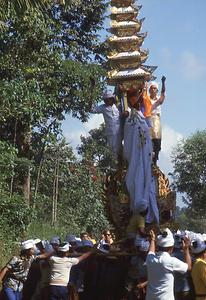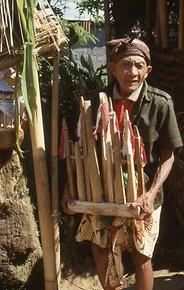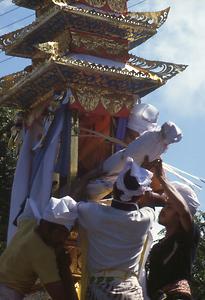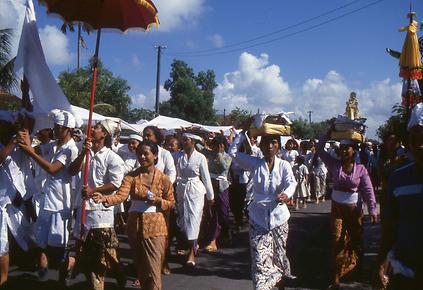Fire frees the soul#
Cremation according to Hindu rituals on Bali#
By G. Jontes
All photos were taken by the author in the years 1976, 1980 and 1987. They are part of his archive "Picure-flood Jontes".
Death breaks the cohesion of body, soul and conscious mind. The “soulless shell”, “the mortal remains” are left over. First the body dissolves slowly, and then more rapidly. It is necessary to eliminate the body before it can be a burden to the living and thus a danger. To preserve the body with various as the Egytian did in antiquity is an expression of material-related thinking that life after death should continue like in the real world. The quality of this life after death depends on the burial objects and the provision with sacrifices.
Regardless of the views about the treatment of the corpse, there are different opinions about the place where the after-life could happen, and will depend on what kidn of life was lead by the deceased. To take stock of good and bad deeds that leads into hell or heaven is not only known in Hinduism and the resulting growing Buddhism with its karma thinking. Christianity also refers to the image of the archangel Michael who weighs the souls at the Last Judgement, and thus also has kind of retributive justice, although the concept of soul in the East differs largely from that of Christianity.
A look back at the Pre- and Early History shows that two basic practices follow each other with changes of time and culture, until they established themselves in parallel in the Modern Age. These are cremation and burial. Burial of the dead in embryonic seated position, the emergence of burial chambers and coffins, ranging from wooden coffins to the ornate stone-carved sarcophagus and the construction of memorials above the earth result in the Christian burial custom assuming that, one day, the human being will be resurrected physically. Therefore, the shell of the dead has to be preserved. The dead shall rise up from the grave when the trumpet calls.
To burn a human being whould thus mean that a robbing of resurrection. It was intended for witches, magicians and especially heretics in the "dark" Middle Ages.
In the Homeric epics, there are the earliest literary references to burning of corpses. Heroes who fell in battle were burnt. While the pyres were burning, the combatants were fighting in Agon, the physical competition, in order to honour the dead hero. In the mysterious Etruscan culture this developed into massive gladiatorial fights. The fights were performed by all social classes of Hellenes, although the splendid decorum was missing. When, during the expansion of the Roman empire, Central and Western Europe came under Roman rule, and a new cultural layer spread over the Celtic tribes, the burning of corpses was only a continuation of what had been customary in the time of urn fields, and then in the Hallstatt culture: cremation on a pile of wood, burial of the ashes in urns, care of the dead, and later the piling up of funeral towers, the tumuli. In the late Antiquity, burial and cremation became the distinguishing feature between pagans and Christians. In the rationalism of the nineteenth century with its cultural, technical and political implications, the cremation emerged again and was accepted by the Catholic Church in 1963.
Judaism also demands the burial of the whole body. The dead has the right to a grave on his own until the moment when the Messiah appears and awakens everything to earthly life. Islam as an amalgam of Jewish and Christian elements which considered unchangeable, as it was proclaimed from the divine mouth. It calls for a simple burial which will last only until everything is resurrected. As in Judaism, the corpse is unclean. A touch requires a cleaning ceremony.
The general reflections point out that mankind has in common certain psychological feelings. In the East far away from the West, in Hinduism and Buddhism, the identity/soul of the deceased is on the way to find a new body shell in the cycle of the rebirths. In both confessions, the reappearance as man, beast, spirit, even as heroes and gods is open. The new shape is the result of the deeds during earthy life the co-called Karma.
To start the path, the earthly part has to be removed by the fire on a wooden pile. Especially Hinduism has developed a richly developed ceremony. A desirable destination where the cremation can take place is the Manikarnika-Ghat on the shore of the Ganges in the most sacred city of India Varanasi/Benares. There, God Shiva dropped one of his earrings. In Nepal, the place of pilgrimage is Pashupatinath on the banks of the river Bagmati that flows into the Ganges far below in India. In popular belief, these places are supposed to guarantee that the soul no longer has to return to the cycle of rebirth which is perceived as painful.
Today, Indonesia is an almost purely Islamic state, and it is even the largest Islamic state of the world by population. In the Middle Ages, merchants introduced this dominant doctrine. Hinduism and Buddhism that were coming from South India were replaced. Only architectural and artistic masterpieces such as the Prambanan and the Borobudur still give evidence of the erlier cultures.
Finally, the drive of Islam to the East weakened. Therefore, the islands Bali and Lombok east of Java remained Hindu. They have kept a moderate caste system. The religious culture is typical for the variety of this tropical, insular world including cremation in a special form that only can be observed here.
As in other cultures in South East Asia, the form of secondary burial is also known in Bali. First, the body is buried. When there are only bones left, the bones are exhumed and then burnt. An astrologer has to determine a favoured date for cremation. This takes place in a special coffin which has the form of a mythical animal. Special craftsmen specialize in the production of such coffins.
The mourners, the oldest son of the dead leading, are dressed in white. In general, the mourning colour is white because of the entire lack of ornaments. Often, mourners get completely in a trance, strengthened by deep mourning and previous fasting.
The mortal remains are put in a parcel into a high funeral tower which is made of bamboo, basketwork, wood and paper, and brought in a procession to the cremation place. Many carriers are necessary to transport the tower. Below the blazing tropical sun, it is an exhausting work as it is seen in the faces of the carriers.








The funeral ceremony is very expensive. Therefore, poorer families are allowed to crowd around the tower in order to say good-bye to their dead on the occasion of such a ceremony.
The coffin is separated from it. Its form gives evidence of the caste system in Bali. A white bull is used for Brahmans, the members of the priest caste. In general, a white cow is is used for a woman. A Ksatria, a member of the old aristocrat and warrior caste goes with a lion on the final journey, a Sudra, one of the lowest caste, lies in a mixed creature. When the funeral procession is leaving the house, the carriers of the tower and coffin are trying to confuse the dead in order to prevent that his soul reoccurs and possibly brings misfortune. The carriers move in all directions, forward and backward. It is a turbulent moment.




The swaying high tower approaches the burial site outside the village. The procession has to cross a waterway. Above, in a throne-like niche, the Brahman sits as priest and indicates the way to the pyre using the soul-symbol bird.






The procession is also accompanied by a Gamelan orchestra, which gives the ceremonial additional meaning and dignity.




In the funeral procession which has turned into a structured procession, women are carrying sacrifices and foods. After the end of the cremation all participants are served to eat. In continental Hinduism the funeral procession and the fire ritual is only attended by men. Women have to stay at home.
Finally, the grove amidst the palms is reached where the pyre is waiting. The animal-like coffin is put on the pyre. The coffin is opened with a special axe and the mortal remains taken from the transport tower are put in it.






The liberated soul disappears with the smoke. What remains after the cremation is collected, and finally thrown into the sea. The human being in his corporeality returns to the nature. The soul can find a new body in order to continue the circle of rebirths.











